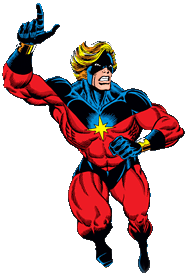Okay, so this guy's first makeover didn't exactly bowl us over.
Aside from the very, very bad writing Captain Marvel was given here, let's look at the things working against Marvel (the company) trying to sell this character in the first place:
- He has the same name as the "Shazam" character, who's long since been established;
- He's a soldier, not a super-hero--no powers to speak of, thus the extreme makeover above;
- He has the same name as the "Shazam" character;
- Unspectacular, unimpressive, blah costume--even worse, it's his uniform;
and, lest we forget:
- He has the SAME NAME as the "Shazam" character
The original Captain Marvel character from Fawsett Comics--the one practically everyone recognizes more, who shouts "Shazam!" and changes in a stroke of lightning from Billy Batson to the good Captain--unfortunately reached a point where he couldn't be marketed with the name "Captain Marvel," due to a copyright infringement suit filed by DC Comics, which inadvertently caused the name's trademark to lapse. In the interim, Marvel swept in and grabbed the name for a new character, Mar-vell--an alien who was sent to spy on Earth but ends up sympathizing with the planet's inhabitants.
It's a premise that takes a long time to shake off--too long. Mar-vell has a nemesis in Yon-rogg, his military superior, who sees him as a rival and a threat, and orders him into one battle after another in the hopes of eliminating him. Unfortunately, Mar-vell's conflict with Yon-rogg didn't interest readers one bit, mostly because Mar-vell is simply playing the good soldier, issue after issue--while Yon-rogg, twirling his virtual villain mustache, lives to plot another day. The intervention of Zo (above) is obviously an attempt to inject Mar-vell with abilities that will give him more appeal; the problem is that he's still embroiled in the same meaningless tug-of-war with Yon-rogg.
Eventually, that conflict is resolved--though tragically, with the death of Mar-vell's lover, Una. Mar-vell later even gets a new costume--as well as another makeover from writer Roy Thomas, and a shameless one at that. Thrown into the Negative Zone, Mar-vell is linked to young Rick Jones, who must bang a pair of wrist bands together in order to switch places with Mar-vell to allow him to fight threats on Earth. All that's missing at this point is the large word balloon "Shazam!" over Jones as he makes the switch.
Enter writer/artist Jim Starlin, whose ideas for the character take Mar-vell to the next level and give him much more dimension and depth. Mar-vell encounters a cosmic entity called Eon, who forces him to both confront his pointless past as well as his uncertain future. It's a turning point a long time coming for both Mar-vell and his readers--a self-realization that perhaps should have occurred far sooner for a Kree warrior who was, for all intents and purposes, directionless on Earth.
Eon, a far more sophisticated version of Zo, is much more practical in the abilities he grants Mar-vell, as this time they mesh with the self-image and direction Mar-vell decides he wants for himself. So while he becomes a more able, self-aware warrior who is more in tune with the universe, we see very little change in his outward appearance. That was also true in his confrontation with Zo, but there's a difference: Zo bestowed only additional powers to Mar-vell, leaving the vengeful, two-dimensional warrior basically intact. In the encounter with Eon, Mar-vell's more important change is within. The evolution of Kree pawn to Kree warrior to cosmically aware protector is now complete:
It's at this point that I become a regular reader of the title, and a more engaged one. Even after his costume change, Mar-vell was still very much the Kree fighter, never looking past the battle he'd become involved in--which meant that all that we saw was a colorful character throwing punches at whatever the issue's threat was. Starlin gave us a more centered character--still a formidable fighter, to be sure, but a more reflective one. And with a more sophisticated Mar-vell came a more interesting cast of characters, including an expanded role for one of Starlin's most memorable creations--Thanos of Titan.
Starlin's transformation issue began one hell of a run on the book--and then another memorable run after that, this time with writer Steve Englehart and artist Al Milgrom. These two arcs, as well as appearances by Mar-vell in other titles, succeeded because they played to Mar-vell's strengths as someone born and trained in a space-spanning empire. Even Marvel seemed to recognize that, stamping each cover with the designation "Marvel's Space-Born Superhero" or "The Most Cosmic Superhero of All." It was a wave of popularity that sustained the character to his death--which occurred in a simply outstanding graphic novel, "The Death of Captain Marvel."
Of course, not willing to let that trademark lapse again, we've seen Marvel bring in other characters to assume the name "Captain Marvel," some having more success with it than others. Yet it's a name that Mar-vell finally was able to make his own--thanks to the timely intervention of Jim Starlin, and an enigmatic creature named Eon.






1 comment:
I actually prefer his initial white and green Kree outfit, perhaps partially more to his quasi-green lantern corps scenario.
As a kid, the red/blue update was super cool, but the white/green initial outfit had that subtle Silver Age 'Kree Soldier' goodness to it, bland perhaps but a soldier uniform.
AND he looked great in it.
Post a Comment